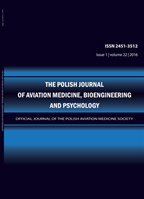2020, Volume 26, Issue 1
AIR FORCE EXPERIENCE INFLUENCES A PILOT’S VISUAL PERCEPTION: PRELIMINARY RESULTS
MARIUSZ PIETRZYK1, KRZYSZTOF KOWALCZUK2, MICHAŁ JANEWICZ2, EWELINA ZAWADZKA-BARTCZAK3, LECH KOPKA1
-------------------------------------------------------------------------------------------------
1Department of Aviation Pathophysiology and Flight Safety, Military Institute of Aviation Medicine
2Department of Simulator Studies and Aeromedical Training, Military Institute of Aviation Medicine
3Department of Internal Disease, Military Institute of Aviation Medicine
Autor korenspondencyjny: MARIUSZ PIETRZYK; Department of Aviation Pathophysiology and Flight Safety, Military Institute of Aviation Medicine; email: dr.mariusz.pietrzyk@gmail.com
Full text
Streszczenie
Abstract: The objective was to characterize visual scanning of a jet fighter cockpit by pilots with different air force experiences using the eye movement monitoring method and flight simulator under G-Force.
Total, 36 pilots with various experiences in piloting MIG-29 participated in the study. Pilots performed basic manoeuvres required for patrolling the air space, including taking off, turning, landing. Experiments were conducted using an human carrying centrifuge with the MIG-29 flight simulator mode. The visual scene was divided into 22 ROI affiliated to cockpit’s instrument and out of widow area. Eye-tracking was performed with The GLASSES portable google sensor manufactured by Sensomotoric Instruments GmBH (SMI, Tetlow, Germany). ANOVA of total dwell time and average fixation duration recorded in each flight phase were run to evaluate statistical significance between the expertise at 95% confidence (p<0.05).
Significant differences in total dwell time and fixation duration on selected ROI were revealed between pilots various experiences, i.e. while patrolling air space regarding attitude director indicator (ADI) and exhaust gas temperature (EGT). The median duration of fixation was also significantly different on altimeter while turning. Fixation duration on airspeed indicator, EGT, IPV were unique for each group during approach landing. Also, the total duration time on the altimeter and ADI were significantly different.
Słowa kluczowe
eye-tracking, visual perception, jet-fighter pilot training, aviation experience
